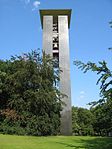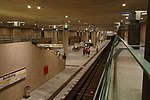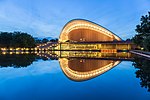German Chancellery

The German Chancellery (German: Bundeskanzleramt, pronounced [bʊndəsˈkant͡slɐˌʔamt] (listen), more faithfully translated as Federal Chancellery or Office of the Federal Chancellor) is an agency serving the executive office of the chancellor of Germany, the head of the federal government, currently Olaf Scholz. The Chancellery's primary function is to assist the chancellor in coordinating the activities of the federal government. The Head of the Chancellery (Chef des Bundeskanzleramtes) holds the rank of either a Secretary of State (Staatssekretär) or a Federal Minister (Bundesminister), currently held by Wolfgang Schmidt. The headquarters of the German Chancellery is at the Federal Chancellery building in Berlin, which is the largest government headquarters in the world.
Excerpt from the Wikipedia article German Chancellery (License: CC BY-SA 3.0, Authors, Images).German Chancellery
Willy-Brandt-Straße, Berlin Tiergarten
Geographical coordinates (GPS) Address Website Nearby Places Show on map
Geographical coordinates (GPS)
| Latitude | Longitude |
|---|---|
| N 52.520277777778 ° | E 13.369166666667 ° |
Address
Bundeskanzleramt
Willy-Brandt-Straße 1
10557 Berlin, Tiergarten
Germany
Open on Google Maps











